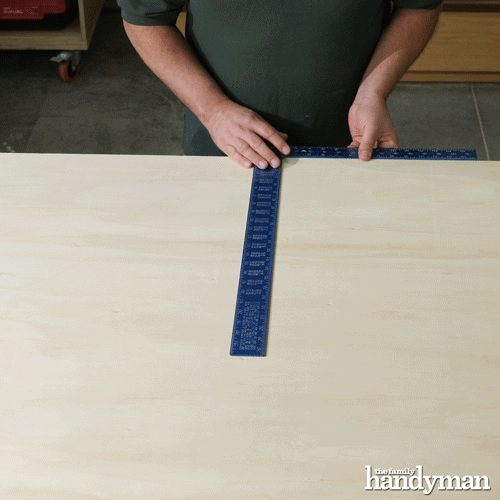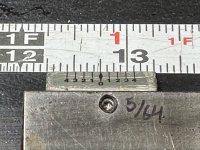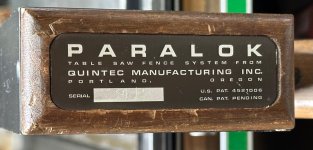Just got the 300mm square. I think it’s off. I register it off the bottom blade and draw a line, flip it 180 and draw another line. It’s a little off. My question is a reference cut from a guiderail straight enough to test the square? I know from testing my TSO guiderail square, the rails aren’t perfectly straight.
You are using an out of date browser. It may not display this or other websites correctly.
You should upgrade or use an alternative browser.
You should upgrade or use an alternative browser.
How to test Woodpecker square tolerance?
- Thread starter ferntree
- Start date
Return it. We'll put it on the optical inspection station. If it's off, we'll fix it or send you a new one that has also been on the vision system. If it's right, we'll send it back to you.
Packard
Member
I was going to describe how to test, but found this article that does a better job.
https://www.familyhandyman.com/article/check-if-a-square-is-square/

Steve1
Member
Assuming you bought one of the expensive stainless steel squares.
According to the Woodpeckers website , they are supposed to be accurate to within .0085 degree. That works out to just under .002" over 300mm.
Unless your day job is machinist, you have no way of measuring that. Best you can do is maybe find a machined or ground straight surface on one of your machines to do the test shown above in the plywood gif. If you can find any consistent error, its out of tolerance.
According to the Woodpeckers website , they are supposed to be accurate to within .0085 degree. That works out to just under .002" over 300mm.
Unless your day job is machinist, you have no way of measuring that. Best you can do is maybe find a machined or ground straight surface on one of your machines to do the test shown above in the plywood gif. If you can find any consistent error, its out of tolerance.
Packard
Member
Mini Me said:Using a drawn line as normally done is asking for errors and bad results as a constant and true angle of the pencil has to be held for the entire line while drawing it.
The test for squareness on the carpenters’ square assumes it is being used for carpentry. For carpentry, +/- 1/16” is probably a reasonable tolerance. For a cabinet maker, half that tolerance.
We, of course, work to much tighter tolerances when we used jigs for dowels, dovetails, finger joints, box joints, etc. But you would not use a carpenters’ square for that.
Indeed, what would be the intended use for a carpenters’ square with those extremely tight tolerances?
Cheese
Member
ChuckS said:Don't use a pencil, and use a marking knife and scribed lines instead to improve the accuracy of the test. If the test repeatedly shows any out-of-squareness, send it in as Jeff advised.
+1
Packard
Member
Again, who is using this and how are they using it? If it is a carpenter using a carpenters’ pencil, then a fresh-from-the-pencil-sharpener #2 pencil would be fine.
I still don’t know the intended audience for this product.

I still don’t know the intended audience for this product.
squall_line
Member
Which square? Woodpeckers makes probably half a dozen 300mm products with "square" in their name...
jeffinsgf said:Return it. We'll put it on the optical inspection station. If it's off, we'll fix it or send you a new one that has also been on the vision system. If it's right, we'll send it back to you.
Nice! I’ll call today.
Tom the Remodeler
Member
- Joined
- Dec 30, 2007
- Messages
- 1,106
Packard said:Again, who is using this and how are they using it? If it is a carpenter using a carpenters’ pencil, then a fresh-from-the-pencil-sharpener #2 pencil would be fine.
I still don’t know the intended audience for this product.

That pencil has been in use for decades in North America, usually by framing carpenters since the thicker graphite will hold up to bigger/longer marks, as compared to a normal #2 pencil. This style is now mimicked by certain models of Pica mechanical pencils, again generally targeted at "first fix" tradespeople.https://www.pica-marker.com/en/pen/pica-big-dry-longlife-construction-marker
luvmytoolz
Member
Tom Gensmer said:That pencil has been in use for decades in North America, usually by framing carpenters since the thicker graphite will hold up to bigger/longer marks, as compared to a normal #2 pencil. This style is now mimicked by certain models of Pica mechanical pencils, again generally targeted at "first fix" tradespeople.https://www.pica-marker.com/en/pen/pica-big-dry-longlife-construction-marker
The issue isn't how long the carpenters pencil has been around, but the query if that's what was used by the OP to check the squareness of a square.
When I think marking accuracy a carpenters pencil is the last thing I think of, as given the lead in a carpenters pencil can vary from 1.25-1.5mm thickness generally, just the act of using it can introduce variability in the pressure applied to the edges of the lead, and the angle it is held, causing inaccuracy.
Packard
Member
luvmytoolz said:Tom Gensmer said:That pencil has been in use for decades in North America, usually by framing carpenters since the thicker graphite will hold up to bigger/longer marks, as compared to a normal #2 pencil. This style is now mimicked by certain models of Pica mechanical pencils, again generally targeted at "first fix" tradespeople.https://www.pica-marker.com/en/pen/pica-big-dry-longlife-construction-marker
The issue isn't how long the carpenters pencil has been around, but the query if that's what was used by the OP to check the squareness of a square.
When I think marking accuracy a carpenters pencil is the last thing I think of, as given the lead in a carpenters pencil can vary from 1.25-1.5mm thickness generally, just the act of using it can introduce variability in the pressure applied to the edges of the lead, and the angle it is held, causing inaccuracy.
My point was that a sharp #2 pencil is accurate enough to test a square the will be used with one of those pencils.
My table saw’s fence has two scales. The top scale is divided into sixteenths of an inch, and that is the scale I usually use. The bottom scale measures 32nds of an inch, and that rarely gets used.
There is no vernier scale on the fence.
A square that has the claimed accuracy to that Woodpeckers scale, would have use in a machine shop where they work with vernier calipers and micrometers. It does not read like a woodworking tool to me.
Woodworkers do work to very tight tolerances when cutting dovetails, and some other joints, but almost never when making gross measurements.
Perhaps the original poster could describe how he intended to use it. It would help us understand his needs.
Also, for the flip / line test to be truly telling .................... the same portion of the reference edge needs to be used. Or the reference edge needs to be checked with a true straight edge first.
In the video above the plywood needs to have a true edge for both "sides" of the flip. I would not be counting on that factory edge as used in the video.
As already said ^ for rough and general carpentry ............ works fine. But for woodworking or machine / tool set up? Not good enough.
Seth
In the video above the plywood needs to have a true edge for both "sides" of the flip. I would not be counting on that factory edge as used in the video.
As already said ^ for rough and general carpentry ............ works fine. But for woodworking or machine / tool set up? Not good enough.
Seth
Michael Kellough
Member
“There is no vernier scale on the fence.”
There is on mine, and I use it all the time.
It’s a simple scale that allows me to read 1/64” directly and makes it easier to move the fence in even smaller amounts.
[attachimg=1]View attachment 2
There is on mine, and I use it all the time.
It’s a simple scale that allows me to read 1/64” directly and makes it easier to move the fence in even smaller amounts.
[attachimg=1]View attachment 2
Attachments
Michael Kellough said:“There is no vernier scale on the fence.”
There is on mine, and I use it all the time.
It’s a simple scale that allows me to read 1/64” directly and makes it easier to move the fence in even smaller amounts.
[attachimg=1]View attachment 2
Nice fence. I remember those even though I didn't have a table saw at the time.
Wow. Vernier scale on the T/S. [thumbs up] But I always seem to struggle to understand and use the vernier scale (because I'm too lazy to refresh what I learned).
About the scale on my SawStop: I never use it unless for cuts that supreme accuracy is not important, or unless every cut for the project is measured and cut using that scale, which seldom happens. The reason is that the tape on the saw in general doesn't match that on my other measuring tapes or rules, which are what I usually use to do measurements. To set the fence, I bring the tape measure or rule concerned to the saw and use it.
About the scale on my SawStop: I never use it unless for cuts that supreme accuracy is not important, or unless every cut for the project is measured and cut using that scale, which seldom happens. The reason is that the tape on the saw in general doesn't match that on my other measuring tapes or rules, which are what I usually use to do measurements. To set the fence, I bring the tape measure or rule concerned to the saw and use it.
Cheese
Member
Packard said:My point was that a sharp #2 pencil is accurate enough to test a square the will be used with one of those pencils.
No...as was mentioned previously, the angle of the pencil must not change because that affects how far off of the edge of the square the pencil mark will be placed. Secondly, as the pencil line is being drawn, the thickness of the pencil line is becoming wider because it is probably a relatively soft grade of pencil lead being used on the wood. Those two combined effects would not allow you to accurately gauge if the square is off more than the .002" specification that Woodpeckers claims.
For accurate assessment, you'd want to use a marking knife or in my case, a carbide scribe because they will give you the accuracy you need.
Now that's what I call Customer Service! I have several WP items which I use regularly and like them a lot. Great to know they back their productsjeffinsgf said:Return it. We'll put it on the optical inspection station. If it's off, we'll fix it or send you a new one that has also been on the vision system. If it's right, we'll send it back to you.
Similar threads
- Replies
- 11
- Views
- 23K
- Replies
- 58
- Views
- 13K


